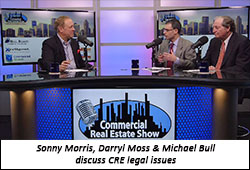Prevalent Commercial Real Estate Legal Issues
Date: 04/03/2015
In commercial real estate, understanding important legal issues has always been essential. But with all the changes today in the marketplace, it’s an even more crucial element of success.
On a recent show I had the opportunity to talk with two prominent lawyers about some of the current legal issues in real estate law. The first thing I had to ask was, what’s different about a real estate law practice in our post-recession marketplace?
Dynamic Practice
 “Well, it’s no surprise that clients are cost conscious, and that’s only intensified,” Sonny Morris, Partner with Morris, Manning & Martin noted. “We’re active partners with clients, creating opportunity as well as protecting and troubleshooting.”
“Well, it’s no surprise that clients are cost conscious, and that’s only intensified,” Sonny Morris, Partner with Morris, Manning & Martin noted. “We’re active partners with clients, creating opportunity as well as protecting and troubleshooting.”
“Beyond that,” he said, “Flexibility is the key.”
Seven or 8 years ago most of the work was in condos or mixed-use developments. As the market turned down, the business moved into REOs. Multifamily projects replaced condominiums.
These days, real estate law firms are also working more in capital markets. As investors continue to pour capital into the market, we’re able to help in the evolving arena of private funding.
Real estate law can be a good career choice. “There’s a great deal of opportunity right now,” said Darryl Moss from Weisman, Nowak, Curry & Wilco. “I encourage young attorneys to consider the practice of commercial real estate law. It’s a practice that requires dedication and focus, but there’s plenty of business.”
School of Hard Knocks
Buyers and sellers, lenders and borrowers all learned tough lessons during the recession.
For instance, today’s borrowers are very concerned with personal guarantees.
“Ten years ago nobody imagined they couldn’t pay their loan one day,” said Moss. “But today, borrowers want to know: what flexibility do I have in the event of default? Everybody is much more cognizant about the downside if things don’t go well.”
Another issue for some borrowers to watch out for are clauses that create a cross default right for lenders. A developer might have one project that is doing great, but another that has default issues. The lender might be able foreclose on several or all of the borrower’s properties, despite the successful performance of one property. Clauses that could allow this might be personal guarantee provisions in the loan, a cross default clause or even a simple sentence in the documents “this property is pledged to secure this loan, and any other indebtedness”.
Lenders learned lessons as well of course. One painful experience some lenders had during the downturn concerned loans made in new residential developments, where their rights in the project weren’t properly secured.
Typically the developer retains rights to approved plans and the HOA.
When a lender has foreclosed on lots or an unbuilt home, they may find themselves seeking permission to build from their borrower they just foreclosed on. The borrower might hold some cards against the lender in these situations. In some recent cases lot owners were unable to gain the right to build, or have any say in governing the community.
Recourse?
“These ‘bad-boy’ carve-outs are a hot topic,” says Moss.
In Michigan the legislature passed a law helpful to borrowers on non-recourse commercial loans. Many non-recourse loans have a bad boy provision that if the borrower becomes insolvent, that can trigger full liability. They declared that against public policy and not an enforceable provision. That was a good decision because the borrower insolvency provision basically turned non-recourse loans into recourse loans.
If you bargained for a non-recourse loan, you may have put in 20% more equity than for the recourse option. For the lender to backdoor their way into a recourse loan like this changes the nature of the bargain. So you definitely want to understand the local climate going in to a deal.
Investors Issues
The biggest issue we see here is that lenders and equity investors want to require general partners to invest substantially, and general partners want to preserve capital for other purposes. Lenders understandably want the general partners to have skin in the game. Equity investors are also a taking hard line, siding with the lender, and sometimes demanding a position in active management, Morris noted.
As the investment sales market has continued to heat up all these issues are hotly negotiated. Now that it’s a sellers’ market, multiple buyers are competing for the same assets. In such a competitive market the pressure is on the buyer to do superb due diligence.
Reps & Warrantees
 Seller representations and warrantees are a negotiated item, where the purchaser wants the reps & warrantees to survive, and the seller wants them to end at closing. It’s in the seller’s best interest for them to be very limited. The things a buyer can do due diligence on, such as the physical condition, they must take the risk. But buyers should get reps and warrantees on the leases, that they are in fact valid, have been executed properly, and have no additional undisclosed clauses. If the seller has defrauded, you need a legal recourse.
Seller representations and warrantees are a negotiated item, where the purchaser wants the reps & warrantees to survive, and the seller wants them to end at closing. It’s in the seller’s best interest for them to be very limited. The things a buyer can do due diligence on, such as the physical condition, they must take the risk. But buyers should get reps and warrantees on the leases, that they are in fact valid, have been executed properly, and have no additional undisclosed clauses. If the seller has defrauded, you need a legal recourse.
Of course, if you can get estoppel certificates from the tenants, that puts an end to potential conflict. If it’s a simple asset entity with no representations and warrantees, be aggressive in your due diligence and get your tenant estoppels. A rep and warrantee just gives you an avenue to a lawsuit, which is ultimately not a satisfying remedy.
Buyers familiar with the post-downturn REO environment learned to be aggressive with their due diligence. Now that it’s a sellers’ market, buyers are assumed to be more experienced.
Lenders also learned from so many defaults, they’re doing their own due diligence on the property’s income. The lenders may insist that tenant credit meets certain criteria, since they may end up with it. They’re paying attention to getting estoppel letters and other detail so they feel comfortable.
Development Issues
Now that the commercial real estate market is thriving again we’re seeing more development action. Early in the recovery there was plenty of apartment-zoned property to be had; now most of that property has been acquired, and there’s a rush to rezone properties to multifamily.
Yet some communities are pushing back, particularly the suburbs, where residents want don’t rentals. At one time these municipalities really wanted the tax base, but people are concerned about their home values and the additional traffic, since transit is usually inadequate in most suburban areas.
Mixed Up in Mixed Use?
Legal issu es in mixed-use development can get complicated, with multiple owners and multiple purposes. In earlier waves of mixed-use, multiple layered associations were created, leading to unforeseen problems.
es in mixed-use development can get complicated, with multiple owners and multiple purposes. In earlier waves of mixed-use, multiple layered associations were created, leading to unforeseen problems.
“I’ve seen situations with up to 4 levels of boards, each with regulations on what you can or cannot do with your unit. This became expensive and unwieldy,” Moss laughed. “It makes plenty of business for us lawyers, with all the ‘who’s responsible for what?’ questions.”
The most important goal for mixed-use covenants is simplicity. These agreements are essentially perpetual, controlling the assets for 50 or more years or more. You want to simplify the process in any way possible.
“We like to take a ‘rough justice’ approach,” says Moss “instead of trying to split all the costs among the members, we find ways to distribute whole expenses somewhat equitably.”
Example: Underground Atlanta
For a great example of a mixed-use project with lots of moving parts, consider Underground Atlanta, now entering its third and most ambitious revival.
In 1910 Atlanta was a busy railroad hub, over 150 trains a day! But it was chaotic and unsafe, so bridges were built over the railways and storefronts. Downtown retailers moved up one or two stories, creating a new street level. The old underground storefronts were rediscovered in the 1980s and reopened as an eclectic entertainment district, very popular in its day.
A master plan for the redevelopment of “Underground Atlanta” is underway, and it’s a massive undertaking. Imagine 11.5 downtown acres and many historic buildings, built over CSX and MARTA tracks. The air rights alone are a major legal component, then historic preservation, the city, and all the owners and investors involved.
“This project must serve the city, the community and the neighborhood on many levels,” said Morris. “It will involve student housing, retail, office, condominiums, restaurants, and entertainment. It’s a city within a city, and the legal work defines its governance.”
In order for all of these entities to interact successfully, the plans must be well thought through before a single brick is laid. A long-term perspective is critical, said Moss, because the covenants required are essentially perpetual.
“As we look ahead, we have to anticipate the need to reinvigorate a project, to keep it successful for 10, 20 50 or more years. Sometimes a condominium needs to become office space, and dismantling a condominium is no mean feat.”
Never underestimate the importance of your legal team. In this rapidly evolving world, they not only provide safety and protection for a business and its assets, but also anticipate changes that will affect the project as time goes on, as well as enhance communication between all the participants in a project or deal.
-

- Michael Bull, CCIM
- Show Host
- Bull Realty, Inc.
- Website
- (404) 876-1640 x 101
Michael's brokerage services: Bull Realty.com
Michael's video training: Commercial Agent Success.com












